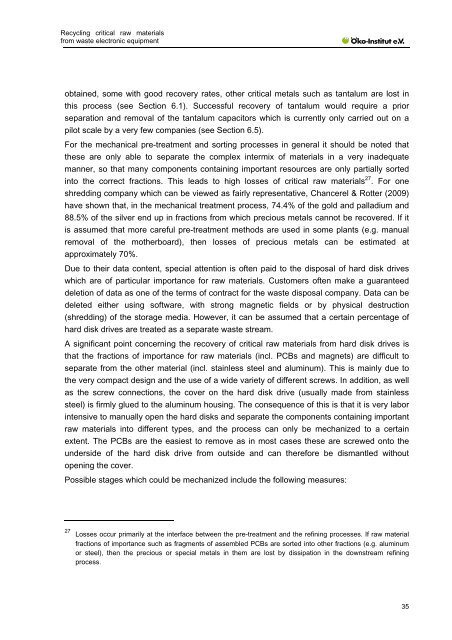Recycling critical raw materials from waste electronic equipment
Recycling critical raw materials from waste electronic equipment
Recycling critical raw materials from waste electronic equipment
Create successful ePaper yourself
Turn your PDF publications into a flip-book with our unique Google optimized e-Paper software.
<strong>Recycling</strong> <strong>critical</strong> <strong>raw</strong> <strong>materials</strong><br />
<strong>from</strong> <strong>waste</strong> <strong>electronic</strong> <strong>equipment</strong><br />
obtained, some with good recovery rates, other <strong>critical</strong> metals such as tantalum are lost in<br />
this process (see Section 6.1). Successful recovery of tantalum would require a prior<br />
separation and removal of the tantalum capacitors which is currently only carried out on a<br />
pilot scale by a very few companies (see Section 6.5).<br />
For the mechanical pre-treatment and sorting processes in general it should be noted that<br />
these are only able to separate the complex intermix of <strong>materials</strong> in a very inadequate<br />
manner, so that many components containing important resources are only partially sorted<br />
into the correct fractions. This leads to high losses of <strong>critical</strong> <strong>raw</strong> <strong>materials</strong> 27 . For one<br />
shredding company which can be viewed as fairly representative, Chancerel & Rotter (2009)<br />
have shown that, in the mechanical treatment process, 74.4% of the gold and palladium and<br />
88.5% of the silver end up in fractions <strong>from</strong> which precious metals cannot be recovered. If it<br />
is assumed that more careful pre-treatment methods are used in some plants (e.g. manual<br />
removal of the motherboard), then losses of precious metals can be estimated at<br />
approximately 70%.<br />
Due to their data content, special attention is often paid to the disposal of hard disk drives<br />
which are of particular importance for <strong>raw</strong> <strong>materials</strong>. Customers often make a guaranteed<br />
deletion of data as one of the terms of contract for the <strong>waste</strong> disposal company. Data can be<br />
deleted either using software, with strong magnetic fields or by physical destruction<br />
(shredding) of the storage media. However, it can be assumed that a certain percentage of<br />
hard disk drives are treated as a separate <strong>waste</strong> stream.<br />
A significant point concerning the recovery of <strong>critical</strong> <strong>raw</strong> <strong>materials</strong> <strong>from</strong> hard disk drives is<br />
that the fractions of importance for <strong>raw</strong> <strong>materials</strong> (incl. PCBs and magnets) are difficult to<br />
separate <strong>from</strong> the other material (incl. stainless steel and aluminum). This is mainly due to<br />
the very compact design and the use of a wide variety of different screws. In addition, as well<br />
as the screw connections, the cover on the hard disk drive (usually made <strong>from</strong> stainless<br />
steel) is firmly glued to the aluminum housing. The consequence of this is that it is very labor<br />
intensive to manually open the hard disks and separate the components containing important<br />
<strong>raw</strong> <strong>materials</strong> into different types, and the process can only be mechanized to a certain<br />
extent. The PCBs are the easiest to remove as in most cases these are screwed onto the<br />
underside of the hard disk drive <strong>from</strong> outside and can therefore be dismantled without<br />
opening the cover.<br />
Possible stages which could be mechanized include the following measures:<br />
27 Losses occur primarily at the interface between the pre-treatment and the refining processes. If <strong>raw</strong> material<br />
fractions of importance such as fragments of assembled PCBs are sorted into other fractions (e.g. aluminum<br />
or steel), then the precious or special metals in them are lost by dissipation in the downstream refining<br />
process.<br />
35

















